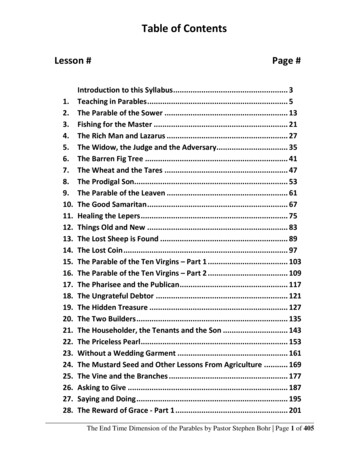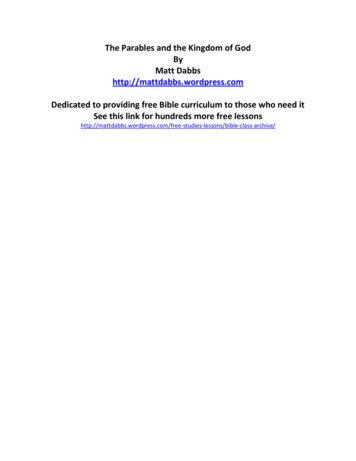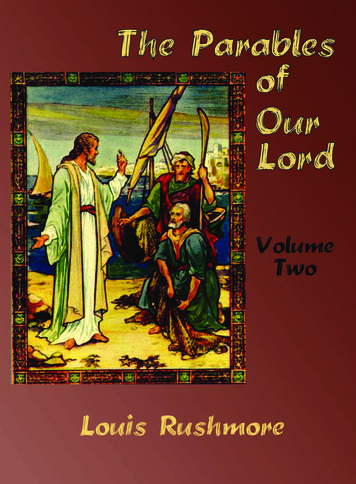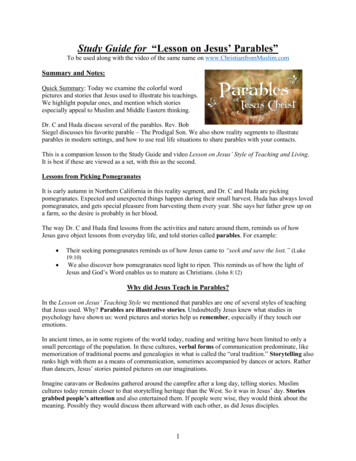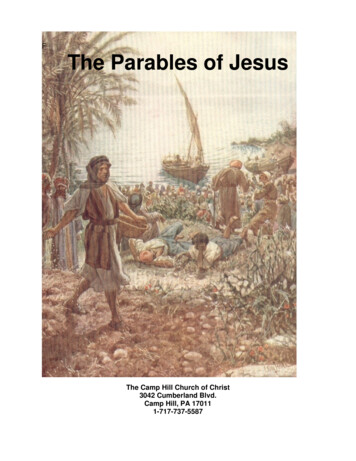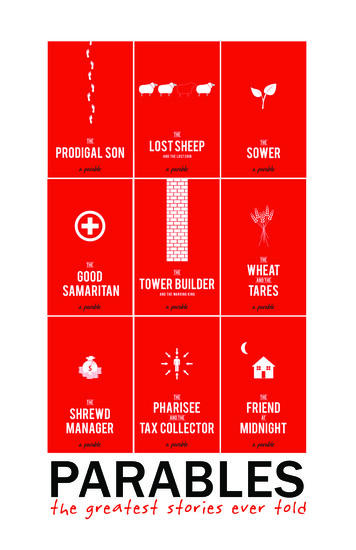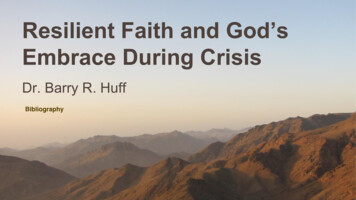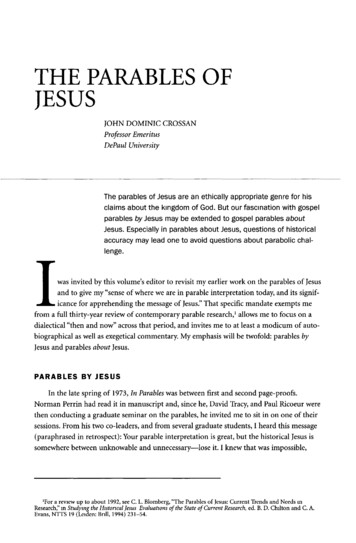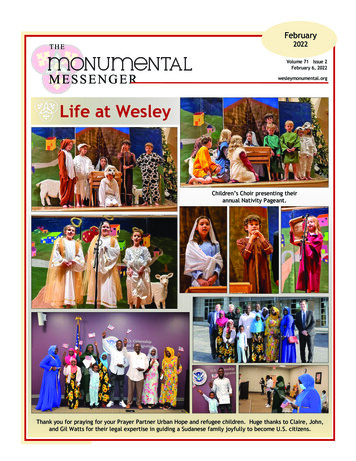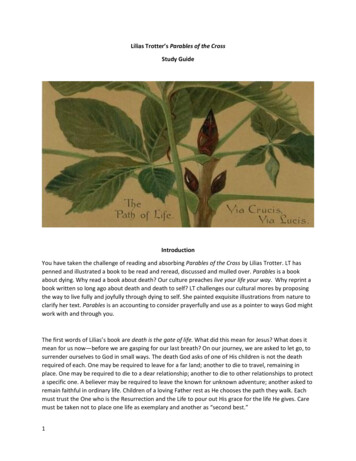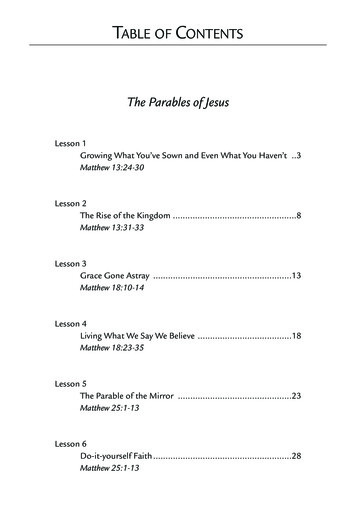
Transcription
TABLE OF CONTENTSThe Parables of JesusLesson 1Growing What You’ve Sown and Even What You Haven’t .3Matthew 13:24-30Lesson 2The Rise of the Kingdom .8Matthew 13:31-33Lesson 3Grace Gone Astray .13Matthew 18:10-14Lesson 4Living What We Say We Believe .18Matthew 18:23-35Lesson 5The Parable of the Mirror .23Matthew 25:1-13Lesson 6Do-it-yourself Faith .28Matthew 25:1-13
WHAT ’S IN YOUR TEACHING GUIDEThis Teaching Guide has three purposes: to give the teacher tools for focusing on the content of the session in the Study Guide. to give the teacher additional Bible background information. to give the teacher variety and choice in preparation.The Teaching Guide includes two major components: Teacher Helps and Teacher Options.Teacher HelpsBible BackgroundTeaching OutlineThe Study Guide is your mainsource of Bible study material.This section helps you more fullyunderstand andinterpret the Scripture text.provides you with an outlineof the main themes in theStudy Guide.Teacher OptionsThe next three sections provide a beginning, middle, and endfor the session, with focus paragraphs in between.Focus Paragraphsare printed in italics at the top of the page because theyare the most important part of the Teaching Guide. Theseparagraphs will help you move your class from “what the textmeant” to “what the text means.”You Can Choose!There is more material in each session than you can use, so choose the options from each sectionto tailor the session to the needs of your group.Prepare Before the SessionRead the session for today in the Study Guide. Then read the options in this TeachingGuide, placing checkmarks beside the activities you plan to include. After you have decidedwhich options to use, gather the appropriate materials.
1LessonTeaching GuideGROWING WHAT YOU’VE SOWNAND EVEN WHAT YOU HAVEN’ TBible BackgroundAn acquaintance of my wifelived with her elderly motherin a small town. Many of thetownspeople held proudly to theirEastern European heritage. My wife oncesaid to her, “It must be good for yourmother to have so many friends from theOld Country here with her.” “Not really,”was the reply. “Our families didn’t muchcare for each other when they lived inEastern Europe, so we avoid each otherhere, too.” I suppose her sentiment islogical: Why bother developing new feudswhen you can just import the old ones?An inherited set of friends and enemieswas also the norm in Jesus’ day. Thefamily into which one was born separatedthe “good people” from the “bad people”ahead of time, and everyone expected youto accept and abide by the divisions(Malina and Rohrbaugh, 103).Understanding these conflicts offers aclearer perspective on Matthew’s view ofGod’s kingdom. The parable of the wheatand the weeds is the first in a series ofparables Jesus told to explain thekingdom of God. We tend to think ofGod’s kingdom as a peaceful place, butfor Matthew it was always under attackfrom the kingdom of evil (Boring, 292).In the parable of the wheat and the weeds,the enemy sows weeds (representing thekingdom of evil) among wheat (representing the kingdom of God).Matthew 13:24-30Like many of Jesus’ parables, thestruggle between good and evil stemmedfrom what scholars call the “honor andshame code” of Jesus’ day, which stressedmaintaining one’s honor and the honorof one’s family (Gowler, 70). One exampleof maintaining honor was to holdgrudges against your family’s enemiesand support your family’s friends. WhenJesus crossed social lines and began toassociate with sinners, he stepped on aland mine labeled “shame and honor.”Jesus made many enemies by being afriend to all.As Jesus struggled to cultivate a spiritof friendship and acceptance thatextended across traditional barriers, hesometimes must have felt like a farmertrying to grow crops in a dry and dustyland. He often used the example of a seedtrying to grow as an image of God’skingdom. In fact, the parable of the wheatand the weeds is sandwiched between twoother parables about seeds. Our parablecomes immediately after Jesus tells ofseeds trying to survive in different typesof soil. The parable of the wheat and theweeds is also about opposing forces. Thencomes a short parable about a mustardseed, which assured victory of God’skingdom through the image of a tiny seedbecoming a large bush.The wheat, unlike the mustard seed,has to struggle to grow. Though thefarmer sows good seed, an enemy comesin and sows conflict. In 13:36-43, Jesus
identifies the sower as “the devil,” butin the parable itself the enemy is notidentified. When the weeds appear, theworkers predictably respond, “Clearout the weeds.” However, as with most ofJesus’ parables, there is a surprise twist. Inthis case, the surprise is that the farmertells the workers to wait before they weed.C. H. Dodd believes the surprise in aparable is the key to its power. The twistin the story introduces a “strangeness”that stimulates “active thought” (Gowler,7). The “strangeness” in this parable is theunpredicted response of the farmer. Hisstatement confronts the hearer with adecision. According to Adolph Jülicher,these moments of decision are whenparables guide us “gently upwards fromthe easy to the difficult” (Gowler, 3-4).The story beckons its hearer to trade inthe predictable for the surprising, totrade in the kingdom of earth for thekingdom of God.Verses 36-43 offer an interpretationthat goes beyond the original parable.Matthew, more than the other Gospelwriters, explains Jesus’ stories ( Jeremias,85). The explanation carries forward theidea of the two kingdoms strugglingagainst each other, and the interpretationof the parable ties it closely to the finalvictory of God’s kingdom, the harvest “atthe end of the age” (13:39). One might betempted to relish the outcome, when“those people” will get what they deserve.However, the primary thrust of theparable is that “those people” are notalways easy to spot; in fact, if we are notcareful, we may meet the enemy anddiscover it is us.Repeatedly, Jesus tried to help peopleresist focusing on the faults of others (seeLk 15:25-32; 18:9-14; Mt 18:21-35).Although subtle, the lesson of thisparable conveys a message: We don’t haveto be self-righteous to judge others tooquickly. Sometimes the combination ofgood motives and impatience is enoughto cause us to hurt a good plant when allwe meant to do was get rid of a weed.4Lesson 1Introduction: The parable of the wheat andthe weeds is about discerning good fromevil. The people of Matthew’s day werekeenly aware of the struggle between God’skingdom and lesser realms. Jesus tells hisfollowers to reject sinfulness, but he alsocautions them to be careful in ascribingguilt to others.I. The Seeds (Mt 13:24-25)A. The kingdom of heaven is like a sowerwho sows good seed (v. 24).B. Secretly, a villain sneaks in and sowsweeds (v. 25).II. The Weeds (Mt 13:26-28a)A. The weeds appear at the same time theplants begin to grow (v. 26).B. The slaves question their master aboutthe source of the weeds (v. 27).C. The master responds, “An enemy hasdone this” (v. 28a).III. Two Responses to the Weeds (Mt13:28b-30)A. The wrong response: tear out theweeds (v. 28b).B. The right response is threefold (vv. 2930):1. Be patient, lest the wheat bedestroyed while removing the weeds.2. Allow time for things to sortthemselves out.3. At the appropriate time, the masterwill judge and mete out punishment.IV. ApplicationA. Why are we tempted to rush tojudgment?B. What forms of evil are hard todistinguish from good?C. How do we remain patient and trustGod?
A Way to BeginThis session is the first of six based on the parables of Jesus. The first story, likeother parables in the study, intends to nudge us upward in our understanding ofwhat it means to be part of the kingdom of God. Your role as teacher is also one ofnudging learners upward until they are ready to address the key question for this session: What isthe believer’s role in the struggle between good and evil? Jesus used parables toengage his listeners, capturing their attention with a story drawn from familiar experience.Capturing attention, however, was not the real goal. Jesus’ goal was to refocus attention upwardtoward kingdom matters. Parable PreviewOn a table, place objects representingeach of the six parables in this unit:Session 1—Garden weeding tool or gloveSession 2—Seed packet or envelopelabeled “kudzu seed”Session 3—Paper with ninety-nine hashmarks at the top, one mark at the bottomSession 4—Dollar bill or stack of playmoney from gameSession 5—Dictionary with the word“obedience” marked and highlightedSession 6—Oil lamp or book of matchesAssign Bible references for the sixparables to individuals or teams (see Tableof Contents for Scriptures). Ask readers toselect from the display an object related totheir parable and briefly describe theparable to the group and tell why the itemthey chose is appropriate.Read aloud Matthew 13:24-30. Usingthe background material, discuss theconflict between the good and bad seed.Then, to refocus the conversation upward,state and discuss the central question:What is the believer’s role in the strugglebetween good and evil?Questions In a society with clear rules fordistinguishing “good” people from“bad” people, how did Jesus break therules? Do believers today need to make suchdistinctions? Why or why not? How are believers to discern betweengood and evil? Good Versus EvilAsk how many have heard the expression“It’s a good thing.” After discussion,explain that today’s Bible study focuseson a parable in which Jesus dealt with theconflict between the good and bad in life.Lead the group to list evidence ofthis conflict in our world (war vs. peace,prejudice vs. tolerance, etc.). As groupmembers suggest ideas, write them on achalkboard. Relate the conflict to the livesof individuals (greed vs. generosity,humility vs. pride) and to the largersociety.Ask learners to scan the printed listwith this question in mind: What is thebeliever’s role in the struggle betweengood and evil? Guide discussion byasking: How is the choice between goodand evil different for believers and nonbelievers? What standards are believers touse in choosing between good and evil?Under what circumstances might abeliever be called upon to make a judgment about the goodness or evil ofanother individual?Explain that Jesus often addresseddifficult questions through parables.Paraphrase the statement of C. H. Dodddescribing the power of a parable tocapture the hearer’s attention andstimulate thinking about its deepermeaning.Read aloud Matthew 13:24-30, askinglearners to keep in mind two questions:(1) How did Jesus capture the attention ofhis listeners and (2) What “good versusevil” conflict is found in the parable?Teaching Guide5
A Way to Explore ScriptureJesus’ parables could be described as deceptively simple. The parable of the good seedversus the bad seed captured the attention of listeners whose lives revolved aroundthe cycles of planting, cultivating, and harvesting. Are the lives of those you teach morelikely to revolve around cycles of workdays and weekends or around calendars, car pools, andchildcare? Can a parable from an agricultural setting still resonate in a fast-paced urban setting?The teaching of Jesus, like the Bible itself, is timeless in its application. The struggle between good and evil is also timeless. Your role is to help learners discover the true meaning ofthe parable and its requirements for their lives. The approaches described below will help you leadthe study. Base your choice on the unique personality of your class. Parable ReadingsEnlist two volunteers to present theparable as a modern dramatic reading.(Setting: Church hallway after monthlybusiness meeting)Member 1: That benevolence committeereport really surprised me. So muchmoney was spent!Member 2: Well, I’m new in the church. Iguess we helped a lot of people.Member 1: Do you think we’re beingcareful about who we help? What if someof those people didn’t deserve our help?Member 2: Hmm. I suppose some peopleare just looking for a handout.Member 1: Maybe we need rules. Youknow, standards for who really deservesour help.Questions What mistake in judgment did theservants in the parable make? How isthat similar to the judgment made byMember 1? What influence is Member 1 having onMember 2? In the parable, who was ultimatelyresponsible for the success or failure ofthe crop?Conclude with this statement fromthe background material: “We don’t haveto be self-righteous to judge others tooquickly. Sometimes the combination ofgood motives and impatience is enoughto cause us to hurt a good plant when allwe meant to do was get rid of a weed.”6Lesson 1 Who’s In Charge?Drawing on your study of the backgroundmaterial, guide the group in studying theparable setting and text. Focus on thetension between the servants’ easysolution to the problem (pulling up theweeds) and the master’s more difficultsolution (cultivating all the plants untilthe time is right).Remind the group of the old story ofthe farmer who, in response to a friend’scomment that “You and God have done agreat job here,” replied, “You should haveseen it when God had it by himself!”Compare the all-too-human desire to be“in charge” to Jesus’ teaching in thisparable. Emphasize the differencebetween the role of the servants (us) andthe master (God).Ask group members to suggestguidelines for making snap judgments.Discuss typical ways people in our societymake quick judgments about others (age,race, physical attractiveness, speech,clothing, etc.). Contrast those ways withthese conclusions from the backgroundmaterial: This parable does not ask us to be blindto sin. It calls us to a spirit of humility aswe look at others. In this parable, as in others, Jesus triedto help people focus on somethingbesides the faults of others. In a world with clear rules for sortingout good people and bad people, Jesusoften broke the rules.
A Way to EndAn appropriate way to end this session is to focus on a beginning. With the Christmasstory fresh in their minds and another new year just underway, adults in your classwill be looking ahead. Two ways to conclude this session are described below. One is apersonal approach designed to help an individual believer respond to Jesus’ teachings. The second isa group approach to help you lead the class in evaluating ways to respond as a group. Rememberthat Jesus’ teaching always included both words and actions. The response ofbelievers, whether individual or group, must also include both words and actions. This last segmentof your Bible study session is a call to action. More or Less ResolutionsAsk learners to suggestways to complete thisstatement: Through theparable of the good andbad seed, Jesus was teaching us to be lessand more . Suggestions couldinclude being less judgmental and moreaccepting, or less self-righteous and morehumble.Hand out the Resource Kit page andexplain its use. Learners will create resolutions like the following two examples: In my private spiritual life:I resolve to be more and less. In my family relationships:I resolve to be more and less.Assure class members that this is personalexercise, with no sharing of resolutions.Allow learners time to complete theirresolutions.Close the session by leading the groupin a time of directed, silent prayer. Givedirections such as these, pausing aftereach statement: Pray for a greater sense of God’s presence in your spiritual life. Pray that God will strengthen yourresolve to be more Christlike in yourrelationships with your family. Pray that God will use you to demonstrate God’s love in your everydaycontacts with others. Pray that God will help you to be morefaithful in your church life. Pray that God will increase your awareness of those in need. Finally, pray that God will grant youhumility and patience as you use yourwords, your actions, and your witness toglorify God. Amen. Class “Hotline”Remind the group that Jesus alwaysdemonstrated love with both words andactions. Write your telephone numberand/or e-mail address where the groupcan see it. Explain that you’re offeringyour number as a “hotline” for classmembers to call when they discover a needthe class could meet. If others volunteerto help, add their numbers to the list.Lead members to consider ways theycould work together to provide help tosomeone in need. Use these questions toguide discussion.Questions What is the January weather like inyour area? Are there people in needbecause of the cold? Homeless shelters and other agenciesoperate year-round. Are volunteersneeded? Are you located near a medical center?Could family members of patients use abreak or a sympathetic listener? Does your local newspaper publish alist of volunteer needs? Are youoverlooking opportunities?Although detailed plans for helpfulprojects cannot be made in the fewremaining minutes, identifying one ormore opportunities is a realistic goal.Teaching Guide7
2LessonBible BackgroundThe parables of the mustardseed and the yeast are briefstories. Surprisingly, theeconomy of Jesus’ words allowsfor numerous interpretations. In suchcases, Mary Ann Tolbert believes it is thereader’s responsibility to help completethe parable by wrestling with it longenough to settle on a meaning (Gowler,24). The Sermon on the Mount (Mt 5–7)aids in understanding these parables. Ineach parable, the kingdom of God iscentral. Like the sermon, the parablesabout seed and yeast turn upside downthe concept of power.Jesus’ brief stories underscore thepower of the seemingly insignificant. Aman dismissed as unimportant by many,Jesus understood that power often residesin unlikely places. It is easy for us tooverlook just how much Jesus would haveresembled a mustard seed in the eyes ofhis world. His lack of worldly status,however, did not keep him from boldlyproclaiming his message. Consequently,the proclamation of this seeminglycommon man yielded immeasurableresults. Like the mustard seed, his ultimate source of power came from beyondhimself. Even so, many still dismissedhim. In the verses following our text,people ask, “Where did this man get thiswisdom and deeds of power? Is not thisthe carpenter’s son?” (Mt 13:54-58). TheyTeaching GuideTHE RISEOF THE KINGDOMMatthew 13:31-33underestimated him, as one might underestimate a mustard seed or a bit of yeast.Some argue that mustard seeds arenot the smallest seeds and that theyproduce a bush, not a tree. However, thistiny seed produces a plant that oftengrows to a height of six feet, and in rarecases up to nine or ten feet. EugeneBoring makes the even more importantpoint: “The parable communicatestheology, not botany” (309). The theologyis tied to botany in that it teaches that thekingdom has the power to grow dramatically. However, less apparent is themeaning of the birds nesting in the bush.Sherman Johnson notes that birdsnesting in a tree symbolize greatkingdoms (see Ezek 31:6) (416). Matthewwrote to Jews who knew the Hebrew storyof the tree mentioned in Daniel, where“the birds of the air nested in itsbranches” (Dan 4:12). This treesymbolized the doomed kingdom ofNebuchadnezzar. By contrast, God’skingdom endures: the world’s emptypower as opposed to God’s eternal power.Matthew logically pairs the parable ofthe yeast with the parable of the mustardseed. The yeast also brings aboutdramatic yield—forty to fifty pounds ofbread (Stagg, 157). Like the mustard seed,yeast has Old Testament connections. InGenesis 18, Abraham tells Sarah toprepare “three measures” of flour fortheir guests. The story opens by “the oaksof Mamre” where guests rest under a tree.
Unbeknownst to Sarah and Abraham,these are sacred guests, and one ofGod’s messengers promises that thecouple will have a son (Gen 18:10). Thisson became the first step in Abraham’sidentity as “the ancestor of a multitude ofnations” (Gen 17:4).George Buttrick captures the messageof both parables, saying, “The kingdomworks by contagion in day-by-dayfriendship. No handclasp is in vain; noword of witness fails of its purpose. Notalways can the revolution be seen, but itmoves on its course. It is irresistible. Itgives lightness and wholeness to theworld—till the whole [is] leavened” (418).These parables challenge our assumptions about power and greatness. We pray,“For thine is the kingdom, and the power,and the glory,” but we often fail to seethe power and the glory in seeminglyinsig-nificant things that are the pillarsof God’s kingdom. Paul described theChristian faith as “foolishness to theGreeks” (1 Cor 1:23). In truth, it sometimes looks like foolishness to us, too.When we hear the word “power,” we aremuch more likely to think of politics orsports than we are to think of God.Good news for us is that the power ofthe seed and the yeast does not residewithin them anymore than it resideswithin us. The greatest message isultimately not about the seed or the yeast,but about the power of the soil and theflour to make the most of the tiny itemsentrusted to them. The miracle is aboutthe power of God. Joachim Jeremiassummarizes, “The modern man, passingthrough the ploughed field, thinks ofwhat is going on beneath the soil, andenvisages a biological development. Thepeople of the Bible, passing through thesame plough-land, look up and seemiracle upon miracle, nothing less thanresurrection from the dead” (149).Introduction: These parables teach us themeaning of true greatness and power. Toooften, we see power only in the extraordinary. The power of God’s kingdom is oftenrevealed through the ordinary.I. The Mustard Seed (Mt 13:31-32)A. The kingdom’s comparison to the seed(v. 31)1. Note last week, when the kingdomwas compared to the sower (Mt.13:24).2. The seed has no power.B. Nature of the kingdom’s power (v. 32)1. Its size is deceptive.2. It has the power to growexponentially.3. It gives itself to serve others (thebirds).4. It is a symbol of God’s enduringkingdom (see the tree of Dan 4:12).II. The Yeast (Mt 13:33)A. There is an allusion to the “threemeasures” of Genesis 18, where asmall act of kindness launched a greatmovement.B. The yeast, like the seed, has no powerunless it gives itself for use in a largerprocess.III. ApplicationA. What kinds of power do weoverestimate and underestimate?B. What can we do to live by thestandards of God’s power?Teaching Guide9
A Way to BeginEvery believer in your class represents a miracle of faith and the power of God. Theparables of the mustard seed and the yeast are stories of dramatic, transformingmiracles. Mustard seed, with the addition of soil, is transformed into a growingplant. Yeast, with the addition of flour, is transformed into life-sustaining bread. Some of the“miracles” who attend your class are in the steady growth phase of their spiritual lives. Their faithis mature, sustaining them as people of God. Others are miracles waiting to happen. Their faithand understanding are still maturing. As you lead your class in this parable study, youcan help provide the soil and flour, the nurturing spiritual environment, thatenables spiritual growth. Begin with ObjectsSet before the group these four objects:packet of seed, container of soil, packetof yeast, and container of flour. Ask avolunteer to pair the objects in the mostappropriate way (seed with soil, yeast withflour). Mention that the pairing isobvious, but important. Seed producesnothing without soil; yeast producesnothing without flour.Explain that each pair of objectsrepresents a parable Jesus told. Brieflyreview the parable from last lesson’ssession. Define parables as a teachingmethod Jesus used to engage his listeners,capturing their attention and refocusingit on kingdom matters.Ask one volunteer to read aloudMatthew 13:31-32 and a second to readMatthew 13:33. Explain that bothmustard seeds and yeast were relativelyinsignificant items. However, the mustardseed grew to great size and the yeast togreat quantity when placed in the properenvironments.If Jesus’ parables were intended torefocus attention on kingdom matters,how do these two parables relate to thekingdom of God? What are somecharacteristics of a person considered“great” by today’s society? What type ofenvironment is most likely to producesuch a “great” person?On a chalkboard, print the session’scentral question: What is the nature ofChristian greatness? Explain that today’s10Lesson 2Bible study is focused on spiritual“greatness.” Begin with ConversationAsk the gardeners in your group to namesome of their favorite plants. Then askcooks in the group to name their favoritefoods. Ask: What do you enjoy aboutgardening or cooking? What motivatesyou to garden or cook?On a chalkboard, print the centralquestion: What is the nature of Christiangreatness? Ask learners to keep thequestion in mind as you read aloud thetwo parables for this session.Read Matthew 13:31-33. Explain thatwhile both the mustard seed and the yeasthad great potential for growth, theirpotential could only be realized in theproper environment. Ask gardeners in thegroup to identify the environment (soil)needed to enable the mustard seed togrow. Call on cooks to identify theenvironment (flour) needed to enablethe yeast to grow. Discuss the potential ofthe mustard seed to grow to great heightand the yeast to grow to great quantity.Questions What are some characteristics of aperson considered “great” by today’ssociety? What type of environment islikely to produce such a person? What are some characteristics of a“great” Christian? What type ofenvironment is most likely to producesuch a person?
A Way to Explore Scripture“Be good” is the universal admonition of childhood. Anxious preschoolers are urgedby departing (and equally anxious) parents to “be good.” Years later, with separationanxiety long replaced by the anticipation of independence, departing college freshmenstill leave anxious parents behind. The admonition to “be good” is no longer spoken or (parentshope) no longer needed. Strong parenting is a daily effort throughout childhood to lay a foundationfor “being good.”What does it mean to “be good” in a Christian context? Is the kingdom of Godonly about goodness, or is there more? Jesus’ parables provide insights into the “more”that is surely needed. The approaches described below are designed to help you guide your class inthis foundational study. Choose the one that fits your group, or blend elements of both for acustomized approach. Parable TeamsForm the group into two teams, one tostudy Matthew13:31-32 and one Matthew13:33. Give both teams the followinginstructions.1. Read the parable.2. Select a “working” title for the parable.3. Answer these questions: What potential for growth did theelement (seed or yeast) in your parablehave on its own? What provided the environment orpower that enabled growth? In a spiritual context, how is God’spower represented in the parable? What are some ways God’s transformingpower is evidenced in the lives ofbelievers today?4. Based on your study, select a final title.Ask teams to share their work with thegroup.Read aloud Matthew 13:53-57. Discussthe ways Jesus may have been perceivedby the people of his day. Focus on thisstatement: They underestimated him, justas one might underestimate a mustardseed or a bit of yeast.To help learners make a personalapplication, read the statements below.Follow each statement with this question:How can God’s transforming power makea difference in the speaker’s life? I can’t teach a Bible study class. I’m justnot good at public speaking. I’m uncomfortable visiting prospectivemembers. I never know what to say. Share my faith with a neighbor? We’venever even talked about church.As time permits, ask learners to sharetestimonies of ways God’s power hasenabled them to accomplish things theycould not have done on their own. Parable Study SheetsUse the first portion of Parable Teams toguide the group in studying the parables.Give each learner the instructionsnumbered 1-4.Begin your study of the first parableby asking learners to share their workingtitle. Use your personal study of thebackground material to supplementdiscussion as learners share their work.Conclude the study by comparing thefinal parable titles selected by learnerswith the ones they first selected. Finaltitles should reflect the true focus of theparable: the transforming power of Godin the lives of believers. Use the sameapproach to the study of the secondparable (Mt 13:33). Contrast the teachingof the parables—that the transformingpower of God is sufficient for all timesand all situations—with contemporarythemes of self-reliance and groupstrength.Teaching Guide11
A Way to EndAdult Bible study classes have at least two things in common: their potential fornumerical growth and the potential of their members for personal spiritual growth.As you conclude this parable study, remember that God is at work in your life as wellas in the lives of your class members. In God’s transforming power, you function as a growth agentfor both numerical and spiritual growth.The two activities described below can help class members practice reachingout to others in a spirit of Christian love. Those whose faith has matured over time shouldfind in these activities a natural expression of their commitment to represent Christ in the world.For newer believers, it may be more challenging. Relying on God’s transforming power will enablethem to participate. A Hundred HandshakesIntroduce the activity by reading thisquotation from the background material:“[God’s] kingdom works by contagion inday-by-day friendship. No handclasp is invain; no word of witness fails of itspurpose” (Buttrick, 418).Ask a volunteer to help youdemonstrate the power of a welcominghandshake. Introduce the volunteer as afirst-time visitor to your church. Shaket
This session is the first of six based on the parables of Jesus. The first story, like other parables in the study, intends to nudge us upward in our understanding of what it means to be part of the kingdom of God. Your role as teacher is also one of nudging learners upward until they are re
